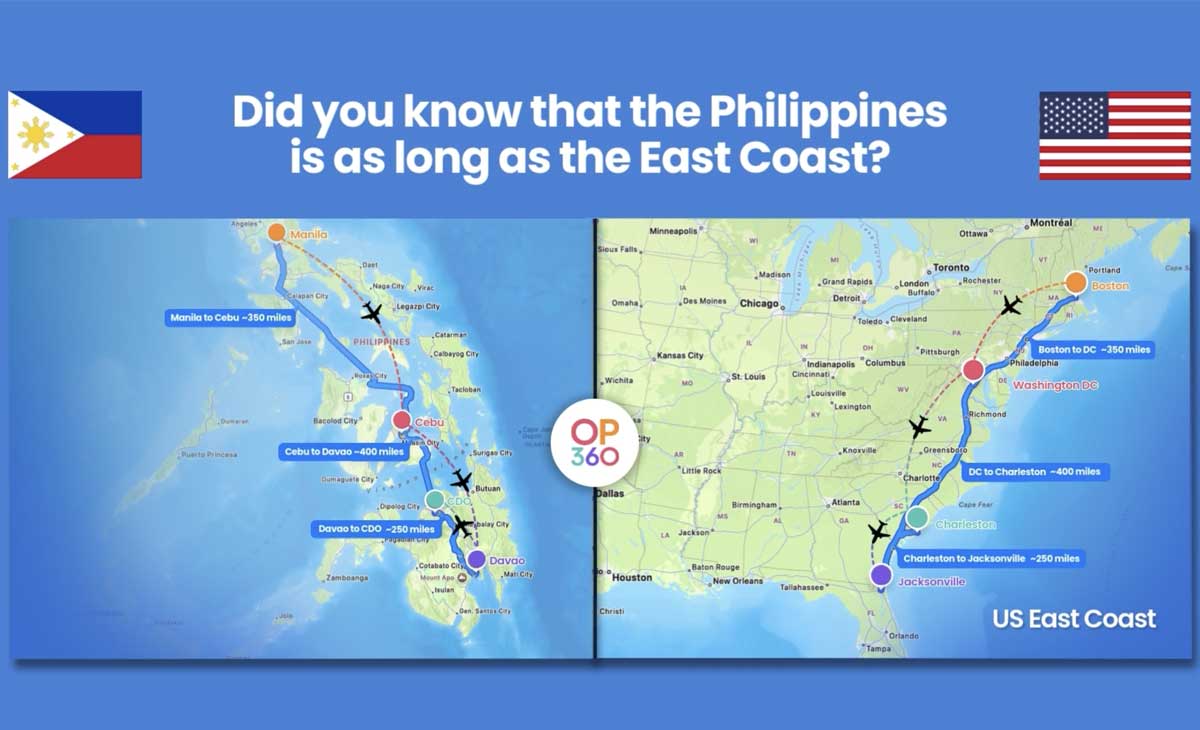The true scale of the Philippines comes as a surprise to many business leaders. This archipelago isn’t just a single location on a map—it’s a vast network of over 7,600 islands stretching approximately 1,150 miles from north to south. To put that in perspective: If superimposed on the U.S. East Coast, the Philippines would span from Boston to Miami.
This geographical diversity isn’t merely an interesting fact—it’s a powerful strategic asset for business continuity planning.
Frontier Cities
The Philippines is divided into three major island groups: Luzon, Visayas, and Mindanao. OP360’s major business centers, located in the cities of Cebu, Davao, and Cagayan de Oro (CDO), are all strategically distributed in the Visayas and Mindanao regions. Cebu is located in the Central Visayas, while Davao is on the southern island of Mindanao. CDO is also on Mindanao, but separated from Davao by significant distance and terrain. The three are all frontier cities, or emerging business centers that offer a robust talent pool similar to the Philippines’ capital in Luzon–minus its congestion and saturated business market.
In terms of distance, traveling between Cebu and Davao mirrors the journey from Washington DC to Charleston, South Carolina. Meanwhile, traveling from Davao to CDO is comparable to the distance between Charleston and Jacksonville, Florida. These significant separations create natural boundaries that enhance business continuity planning.
What makes this distribution particularly valuable is that all three centers offer exceptional accessibility despite their geographic spread. Cebu is served by Mactan-Cebu International Airport, the country’s second-busiest airport, offering direct international flights from Hong Kong, Singapore, Seoul, Tokyo, Dubai, and beyond. With over 120 daily domestic flights to major Philippine destinations and a modern terminal capable of handling 12.5 million passengers annually, Cebu serves as a critical connection point.
Davao’s Francisco Bangoy International Airport functions as Southern Philippines’ main international gateway, with direct flights to Singapore, Hong Kong, and other regional hubs. The airport handles more than 75 weekly domestic flights connecting to Manila, Cebu, and other key cities, and is currently undergoing expansion to increase capacity.
In Cagayan de Oro, Laguindingan Airport provides modern access to Northern Mindanao with over 50 weekly flights to Manila, Cebu, and other domestic destinations. This airport serves as a critical access point to the northern Mindanao economic corridor, ensuring the region remains well-connected.
All three cities feature modern hotels, reliable transportation, and improving infrastructure that make business operations and travel efficient and comfortable throughout the archipelago.
Weather Diversity: A Natural Redundancy
The Philippines’ varied topography creates distinct weather patterns across these regions, providing another layer of business continuity advantage for OP360’s sites. Cebu, in the Central Visayas, is relatively sheltered from most typhoons by surrounding islands. It experiences a dry season from December to May and a wet season from June to November, with typhoon risk primarily concentrated from August to November. The region receives approximately 1,600mm of average annual rainfall.
Davao, situated in Southern Mindanao, lies outside the typical typhoon belt and experiences more evenly distributed rainfall throughout the year. It has minimal typhoon impact—often referred to as “typhoon-free.”
CDO’s weather patterns are influenced by mountains and Macajalar Bay, with rainfall distributed throughout the year and slight peaks from May to July. The area experiences moderate typhoon exposure, but still less than Luzon.
These weather systems impacting one region often leave others unaffected. What elevates this distribution from good to exceptional for business continuity is not just the distances involved, but the natural barriers between locations. The centers are located on different islands or geographic regions and separated by significant water bodies. They sit on different tectonic plates, utilize independent power grids and infrastructure, and experience varied weather patterns and typhoon exposure profiles.
This geographic distribution delivers crucial advantages for business continuity planning. First, it provides natural disaster isolation, where events affecting one center rarely impact others. Second, it ensures infrastructure independence through separate power grids and telecommunication networks. Third, it offers transportation diversity with multiple sea and air routes connecting locations. Fourth, it creates weather resilience through different monsoon patterns and typhoon exposures. Finally, it provides access to distinct talent pools in each region, enhancing workforce availability.
The Strategic Imperative
When viewing the Philippines through the lens of business continuity, it becomes clear that distributing operations across these centers isn’t merely feasible—it’s a strategic imperative. The geographic scale, excellent connectivity, diverse weather patterns, and natural barriers between locations provide built-in redundancy and risk mitigation difficult to achieve elsewhere.
For forward-thinking industry leaders, the Philippines’ archipelagic nature doesn’t represent a challenge but rather an opportunity—a natural framework for creating resilient operations in an increasingly unpredictable world.



